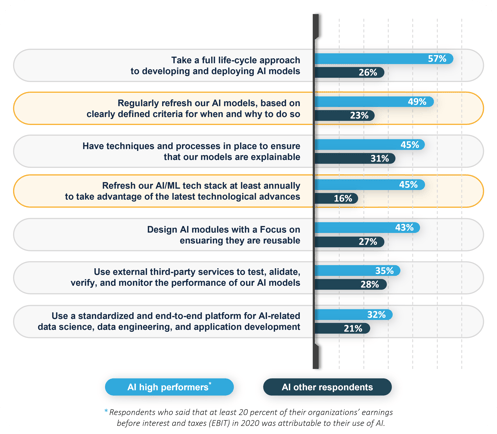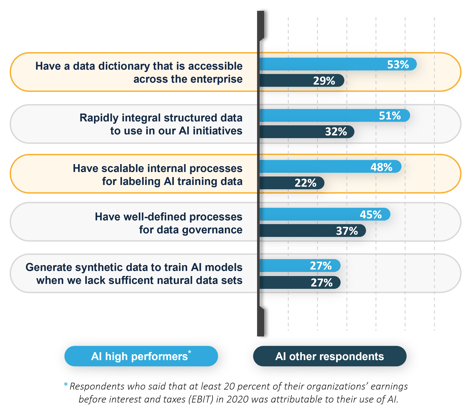In December 2021 McKinsey published a report entitled “The State of AI in 2021”. This article is part of my subjective analysis of this publication. You can find the key conclusions at this link - I will also provide links to other parts of the analysis.
Companies that are leading the way in the use of AI are much more aware of the value and need to nurture the development of AI models.
Once manufactured, the model can theoretically operate for several months. In practice, however, it may turn out that it is only sufficient for a short period of time, e.g. until a sudden market change occurs.
Even without rapid changes in the market, which is rare in the VUCA world, most AI models become less effective over time. We know this from our own experience, but as McKinsey points out, only companies with extensive experience in AI realize this. Of course, the sustainability of the model depends largely on the industry and the application of AI. At PBS, we mostly use AI for Image Recognition to control the availability and exposition of products at the point of sale. In our case, taking care of the network is particularly important. In order for the model to maximize its potential, it is necessary to constantly feed and train it with new data. For example, new products are constantly appearing in the offer of each company. Products that have been present so far, change the packaging, dimensions, shapes, or promotional communication are displayed on them. In the case of Image Recognition, undeveloped AI “dies” quite quickly.
The McKinsey study identifies several levels of best practice in caring for AI networks:
- Basic,
- Advanced data management,
- Advanced modeling, tools, and technologies,
- User involvement.

Based on McKinsey report "The state of AI in 2021".
These differences in understanding the importance of AI development can be seen in each of the above levels. I was particularly impressed by the third level of best practice, including the awareness that AI models need to be regularly refreshed based on clearly defined criteria. In this case, the difference between “AI high performers” (i.e. organizations that are leading the way in applying AI) and the other respondents exceeded 100%. Experienced users declare that they use this practice up to three times more often.
Another element that advanced AI users notice much more frequently is the need to refresh the suite of technologies supporting AI at least once a year. Respondents from these companies point to this practice as an important factor in gaining sustainable competitive advantage, as much as 3 times more often than novice AI users.
New scientific papers in the field of AI development are published virtually every month, and new techniques and technologies for training AI network are emerging every month as well. New mechanisms enter the market to make AI training, control, and performance development easier and more effective. Just a few years ago, it would have been impossible to build a network operating in an environment without Internet access, installed on a mid-class phone, handling the recognition of several hundred products at the speed of several dozen verifications per second.
We are talking about an application that works offline and can be installed on a generally accessible device, e.g. with the Android OS. This seemed like an unattainable goal back 2-3 years ago. Now, we might say, that, we have been building such AI networks for many months now and have developed an application that makes this possible.
It is worth adding that AI is a very broad concept, increasingly supporting humanity. Following the detailed scientific progress in the whole field of AI is not possible without having very advanced knowledge and resources. This defocus in my opinion, does not make sense in many cases. Having internal expertise in any AI area, can be very expensive and often unprofitable for organizations. Hence it’s much better, to find partner who focuses on specific AI area. For instance we, as an external provider , have been focusing on AI development, in advanced Image Recognition services, for over 6 years, deepening and developing our knowledge in this particular area. We are constantly looking for the latest technologies, developing our own tools and processes, and implementing them in our production chain.

Based on McKinsey report "The state of AI in 2021".
The section on good data management practices is also worth reading. My attention was particularly drawn to the results of the study in terms of having a dictionary of data and processes that can be scaled in terms of labeling the data, and preparing it to suit the training set. Why are these two elements so important?
Having the right structure and order of the input data is important for the same reason as having a proven process for labeling the input data to the training set. This is nothing more than a basis for AI learning. Simply put, one of the most frequently used AI training methods is to indicate a set of correct and incorrect answers to a specific problem (so-called supervised learning). Both correct and incorrect answers should be labeled accordingly. AI develops its algorithms, creating a network in such a way that maximizes the compliance of its own responses with the responses from the training set. To create a good AI, we need to be confident in the answers indicated in the training set. If the set is cluttered, if the answers are mislabeled, a model trained on such a set will have little credibility. In case of Image Recognition, proper labeling of the input data is a very complex and intricate process.
According to the McKinsey report, awareness of the importance of the above factors is at least twice as high among experienced AI users. It is worth noting that among novice users, only about one in five respondents understand the importance of this problem. I also find it quite worrying that only one in two respondents with extensive experience noticed this challenge. In my opinion, far too few managers involved in AI, or possibly in procuring these services, realize how important AI learning processes are and how many details need to be addressed for AI to deliver satisfactory results.
It is essential to realize that AI, once produced, does not work indefinitely. In our line of business, we ourselves encounter proposals such as: “So, produce the AI network for us, and we will handle it from there”. The network must be nurtured like a living organism. All related activities in this still pioneering field must be continuously improved. It is a very complex and complicated process. At the same time, I am aware that for many people who want to use AI, it is invisible or not very tangible. In the end, "Artificial Intelligence" contains the word "Intelligence" in its name, which automatically suggests that it should be capable of further developing and updating itself on its own.
👉 Follow us on social media to stay up to date:



